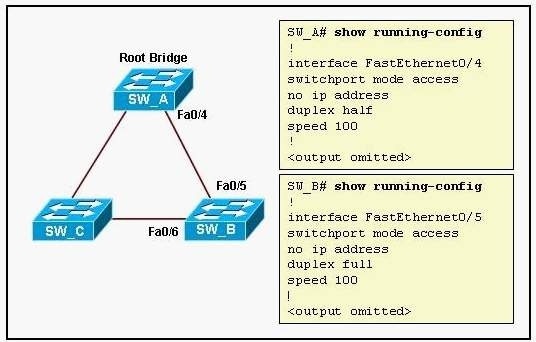Refer to the exhibit and the partial configuration of switch SW_A and SW_B. STP is configured on all switches in the network. SW_B receives this error message on the console port:
00:06:34: %CDP-4-DUPLEX_MISMATCH: duplex mismatch discovered on FastEthernet0/5 (not half duplex), with SW_A FastEthernet0/4 (half duplex) ,with TBA05071417(Cat6K-B) 0/4 (half duplex).
What would be the possible outcome of the problem? *


A.
The root port on switch SW_A will automatically transition to full-duplex mode.
B.
The root port on switch SW_B will fallback to full-duplex mode.
C.
The interfaces between switches SW_A and SW_B will transition to a blocking state.
D.
Interface Fa 0/6 on switch SW_B will transition to a forwarding state and create a bridging loop.


How does this happen?? Explanation please?
0
0
The line between SWA and SWB will not go down, but due to collisions, the BPDU’s would get lost. SWB will assume that SWA is no longer the root and since Fa0/6 is the only other way to the root, it will start sending traffic over 0/6.
0
0
http://www.cisco.com/en/US/tech/tk389/tk621/technologies_tech_note09186a00800951ac.shtml#duplex
0
0
The worst-case scenario is when a bridge that sends BPDUs has the duplex mode set to half-duplex on a port, but the peer port on other end of link has the duplex mode set to full-duplex. In the above example, the duplex mismatch on the link between bridge A and B can easily lead to a bridging loop. Because bridge B has configuration for full-duplex, it does not perform carrier sense before link access. Bridge B starts to send frames even if bridge A is already using the link. This situation is a problem for A; bridge A detects a collision and runs the backoff algorithm before the bridge attempts another transmission of the frame. If there is enough traffic from B to A, every packet that A sends, which includes the BPDUs, undergoes deferment or collision and eventually gets dropped. From an STP point of view, because bridge B does not receive BPDUs from A any more, bridge B has lost the root bridge. This leads B to unblock the port connected to bridge C, which creates the loop.
0
0
gustavo has better explanation. i get it now
0
0